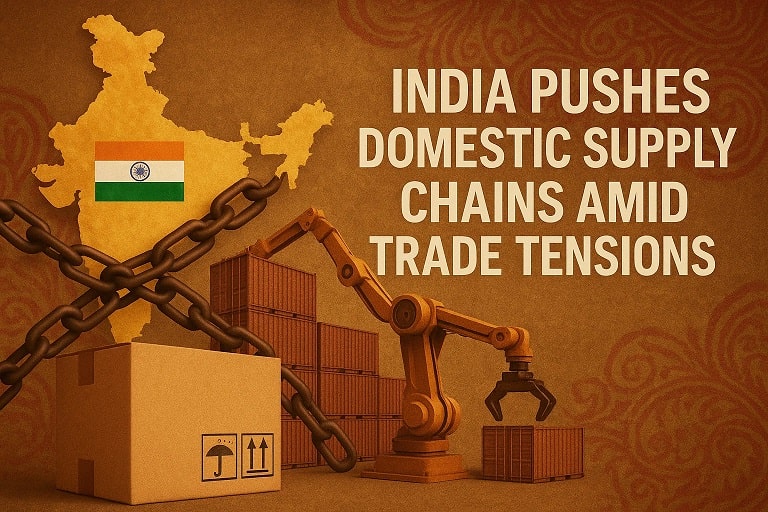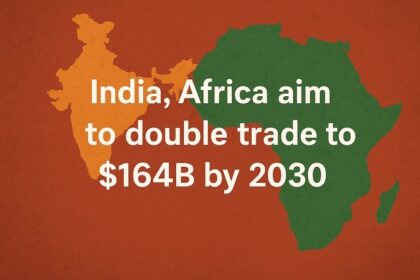India Pushes Domestic Supply Chains Amid Trade Tensions: Building Resilience in a Fragmented World
Amid escalating US-India trade tensions in 2025, marked by 50% tariffs on Indian exports excluding pharmaceuticals and energy, India is aggressively promoting domestic supply chains to mitigate risks and enhance self-reliance. Initiatives like “Make in India 2.0” and the Production Linked Incentive (PLI) scheme have attracted $20.3 billion in foreign investment, focusing on electronics, EVs, and semiconductors. As global supply chains fragment due to US tariffs and geopolitical pressures, including India’s continued Russian oil imports, the government is diversifying trade partners through FTAs with the UK, EAEU, and EFTA. This strategic pivot aims to reduce import dependency, create jobs, and position India as a manufacturing alternative to China. This article explores the drivers behind this push, historical context, future prospects, and impacts, with a focus on Tamil Nadu’s pivotal role as a semiconductor and EV hub.
Why This Push Matters
The US tariffs, imposed in August 2025 as retaliation for India’s Russian oil procurement and trade imbalances, threaten $87 billion in annual exports, particularly in textiles, gems, and machinery, potentially causing 70% collapse in labor-intensive sectors. By bolstering domestic supply chains, India seeks to insulate its economy, attract FDI, and leverage its 1.4 billion consumer market. For Tamil Nadu, home to TSMC’s $10 billion chip plant and Foxconn’s EV facilities, this creates opportunities in high-tech manufacturing, potentially adding ₹15,000 crore to the state’s GDP by 2030 and aligning with IMC 2025’s tech innovation focus.
Latest Developments Driving the Push
India’s response to trade tensions has accelerated domestic supply chain reforms, with key actions in 2025:
- Tariff Impacts and Shifts: US 50% tariffs have triggered capital flight from textiles and gems, with firms like Vardhman Textiles relocating to Vietnam (20% tariff) and Bangladesh (15%). Auto parts, exempt, offer hope for Tata Motors and Mahindra, but overall, $3 billion in FII outflows occurred in July-August 2025, weakening the rupee to 88 per dollar.
- PLI Scheme Expansion: The PLI has drawn $21 billion in investments by mid-2025, boosting electronics (PLI attracting $10 billion) and semiconductors. TSMC’s Tamil Nadu plant exemplifies this, with 100% FDI policy enabling rapid scaling.
- Trade Diversification: India finalized the UK FTA in 2025 and is negotiating with EAEU, offsetting US reliance. Domestic reforms like GST overhaul and interest subsidies support “Make in India 2.0,” focusing on EVs and renewables.
- Infrastructure Boost: PM Gati Shakti and Unified Logistics Interface Platform (ULIP) reduce logistics costs by 14%, enhancing supply chain efficiency. Dedicated Freight Corridors and digital tracking aid EXIM cargo.
- Sector-Specific Measures: Duty reductions on mobile components (e.g., PCBs, cameras) and lithium-ion machinery in the 2025 Budget fast-track electronics self-sufficiency.
Tamil Nadu’s Context
Tamil Nadu leads with TSMC’s chip fab and Foxconn’s Sriperumbudur EV plant, producing 14% of global iPhones. The state’s 100% FDI in semiconductors and PLI incentives position it to capture 25-40% of India’s electronics output, creating 50,000 jobs and exporting $5 billion by 2030.
Historical Context of India’s Supply Chain Evolution
India’s journey toward domestic supply chains has been shaped by global disruptions and policy reforms:
- 1991-2000s: Liberalization post-1991 crisis opened markets, but reliance on imports grew, with China dominating 75% of electronics components.
- 2014: “Make in India” launched to boost manufacturing to 25% of GDP, focusing on 25 sectors like defense and EVs.
- 2020: PLI scheme introduced with ₹1.97 lakh crore across 14 sectors, attracting $20 billion by 2023 in mobile manufacturing.
- 2022: US-China tensions and COVID accelerated “China Plus One,” with Apple shifting 10% production to India.
- 2024-2025: US tariffs and geopolitical risks (e.g., Russia-Ukraine) prompted FTAs and duty cuts; India’s smartphone exports rose 42% in 2024.
Tamil Nadu’s evolution from textiles to semiconductors mirrors this, with Foxconn’s 2020 entry scaling to 20 million iPhones annually.
Future Scopes and Projections
By 2030, India’s domestic supply chains could reduce import dependency by 50%, with manufacturing at 25% of GDP. Projections include:
- Electronics and Semiconductors: PLI to attract $50 billion FDI, with Tamil Nadu’s TSMC plant reaching full capacity by 2027, exporting $10 billion.
- EVs and Renewables: 30% EV adoption, with Tamil Nadu producing 20% of India’s EVs, supported by lithium incentives.
- Trade Diversification: FTAs with EAEU and CPTPP to boost exports to $2 trillion, offsetting US tariffs.
- Logistics Efficiency: Gati Shakti to cut costs 20%, with ULIP enabling real-time tracking.
Long-Term Strategic Outlook
By 2035, India aims for Viksit Bharat with self-reliant chains in 20 sectors. Tamil Nadu could lead semiconductors, adding ₹30,000 crore to GDP. Challenges: Infrastructure gaps, skilled labor shortages (2 million STEM graduates needed), and US tariffs persisting at 25-50%.
Impacts on the Indian Economy and Stakeholders
The push could add $1 trillion to GDP by 2030, with Tamil Nadu at the forefront.
Sector-Wise Impacts
Electronics and Semiconductors
- Impact: PLI reduces import reliance from 75%; Tamil Nadu’s TSMC fab creates 50,000 jobs.
- Economic Contribution: ₹20,000 crore exports, with Tamil Nadu at 40%.
- Business Opportunities: Chennai startups supply components to global firms.
Textiles and Manufacturing
- Impact: Tariffs hit 70% exports; diversification to Vietnam, but “Make in India” revives domestic production.
- Economic Contribution: 1 million jobs, with Tamil Nadu’s Tiruppur adapting via PLI.
- Business Opportunities: Coimbatore firms shift to EVs from textiles.
Energy and Renewables
- Impact: Russian oil imports trigger tariffs, but green hydrogen mission secures chains.
- Economic Contribution: ₹10,000 crore in solar exports, Tamil Nadu at 20%.
- Business Opportunities: Vikram Solar scales for global supply.
Impact Snapshot
| Sector | Key Initiative | Tamil Nadu Impact |
|---|---|---|
| Electronics | PLI Scheme | TSMC fab, 50,000 jobs |
| Textiles | Diversification | Tiruppur adaptation, ₹5,000 crore |
| Renewables | Green Hydrogen | 10 GW solar, ₹2,000 crore exports |
| Overall (2030) | $1T GDP Addition | ₹30,000 crore from state |
Frequently Asked Questions (FAQs)
What triggered India’s domestic supply chain push?
US 50% tariffs in 2025 on $87 billion exports, due to Russian oil imports and imbalances, prompting PLI expansion and FTAs.
How does PLI support this?
It attracted $21 billion by mid-2025, boosting electronics and EVs, with Tamil Nadu leading semiconductors.
What’s Tamil Nadu’s role?
TSMC’s $10 billion plant and Foxconn EV facilities position it for 25-40% of India’s output, creating 50,000 jobs.
What challenges remain?
Infrastructure gaps, labor shortages, and persistent tariffs could slow progress.
How does this align with global trends?
It fits “China Plus One,” with India gaining from US-China tensions, exporting $2 trillion by 2030.












